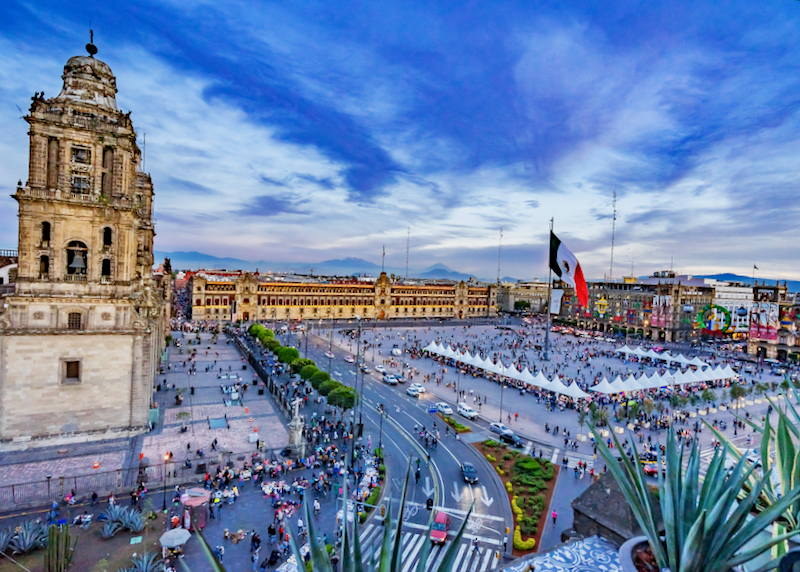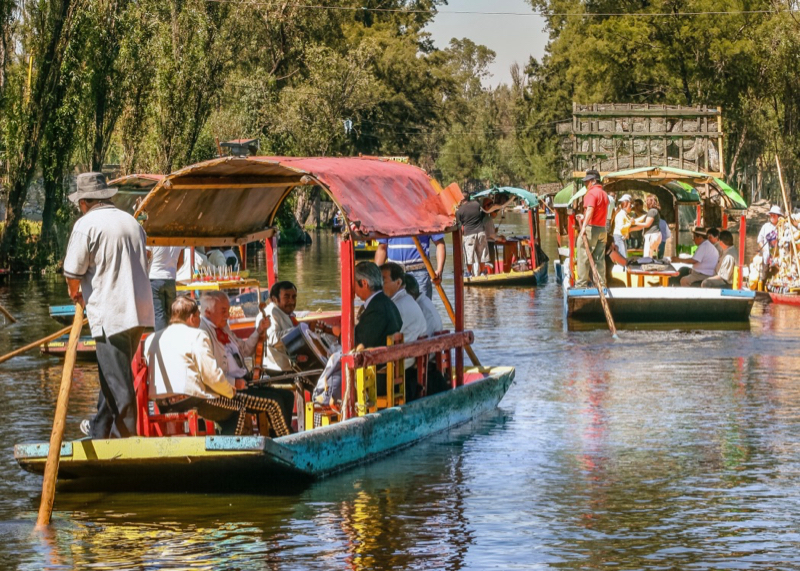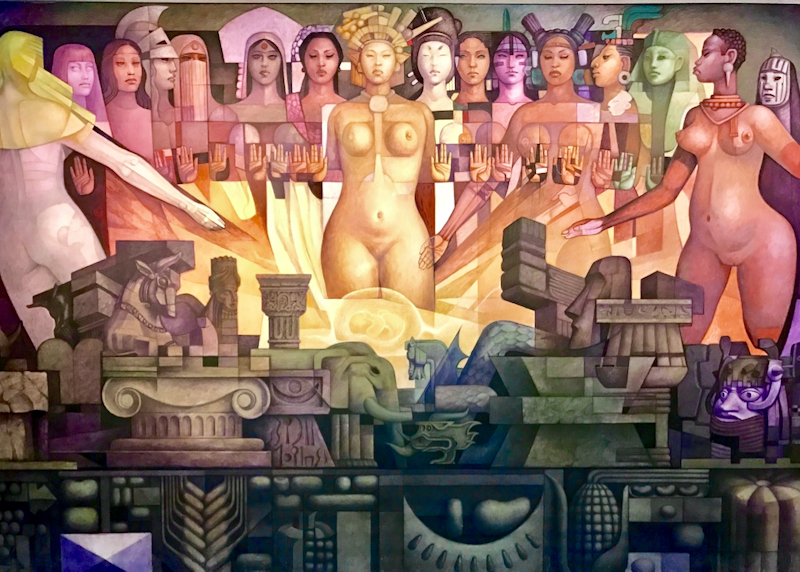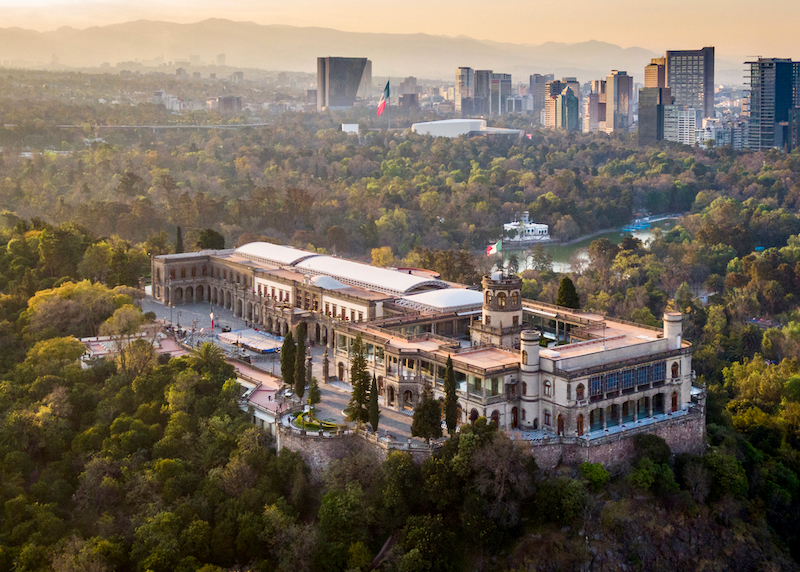Mexico › Mexico City
Updated: March 1, 2022
Mexico City Articles
- Mexico City – Where to Stay
- Mexico City – Best Restaurants
- Mexico City – Best Time to Visit
- Mexico City – Itinerary for 1, 2, 3, & 7 Days
- Mexico City – Jewelry Designers

The zocalo square is the heartbeat of the nation, in the center of downtown Mexico City. The plaza hosts public concerts, social, cultural, and political events throughout the year.
Frequently Asked Questions about Mexico City
Where is Mexico City?
Mexico City is located in the Valley of Mexico, an inland basin in the center of Mexico. It sits at an altitude of 7,350 ft (2,240 meters), so it’s not uncommon for visitors to the Mexican capital to experience shortness of breath while climbing stairs and pyramids. Mexico City is surrounded on three sides by the Estado de México, part of which is considered to be within the city’s metropolitan area.
How big is Mexico City?
Mexico City’s population is estimated at 21,782,378 in 2020, making it the most populous city in North America. This number includes Mexico City proper and its adjacent suburban areas. Without counting its metropolitan area, Mexico City occupies a land area of 571 square miles (1,479 square km) and has an estimated population of 8,918,653 (based on 2016 estimates).
What is the history of Mexico City?
Mexico City was founded by the Aztecs on the shores of what was once a lake, which explains why parts of the city sink a few inches each year (visitors can notice that by standing in front of the Cathedral). In 1521, the city of Tenochtitlán —as it was known back then— was colonized by the Spaniards and it became known as the New Spain. Three centuries later, the country gained its independence and changed its name to Estados Unidos Mexicanos (United Mexican States).
How do I get to Mexico City?
Flights to Mexico City take 3.5 hours from Los Angeles, 4.5 hours from New York City, and about 2 hours from Cancún. As a major hub, it also has direct flights to/from most European capitals and several South American cities. The flight from London takes around 12 hours and flying from Sao Paulo usually takes around 9.5 hours.
Alternatively, Americans who live near the border can cross by land and take a low-cost flight from Tijuana.
When is the best time to go to Mexico City?
Visitors who are after warm weather would do well to visit around spring break when the city is at its warmest. Contrary to logic, summer is not actually warm in Mexico City: it rains every evening and clouds abound during the day. Those wanting to avoid the crowds should visit in December when local Mexicans flock to the beaches. The sky tends to be blue during that time, there’s virtually no traffic, and no rain —the one downside is that days are shorter. Rainy season extends from May/June to October each year, although seasons have been a bit erratic in recent years.

Floating the canals of Xochimilco, boats carrying live mariachi musicians serenade visitors, and sell delicious food and cold drinks.
What neighborhoods should I visit in Mexico City?
Mexico City is huge, but there are some neighborhoods that hold more of an interest to visitors and expats alike. Trendy Roma and Condesa are an obvious place to start, with their myriad restaurants, bars, shops, and weekend popup markets. Swankier Polanco has fine dining options visitors will want to check out, as well as parks to take a stroll and check out daily city life (our recommendation is Parque Lincoln). Further south, the neighborhoods of Coyoacán and San Angel offer a dose of culture. Coyoacán is home to Frida Kahlo’s home turned museum, Casa Azul, and San Angel’s cobbled streets are at their best on Saturdays, when an artisanal market takes hold of the neighborhood. Any day of the week is good to check out Centro Histórico, the city’s historic center, where colonial architecture and pre-Hispanic ruins converge, evidencing Mexico City’s multicultural history.
Where should I stay in Mexico City?
It’s a good idea to stay in central areas of the city in order to move around easily. Hotels along Paseo de la Reforma avenue and in the Polanco neighborhood offer the possibility to get to know the city on foot. The same is true of Roma and Condesa, although accommodation options in those areas tend to be of the smaller boutique hotel variety or Airbnbs. The city center (centro histórico) has lovely colonial buildings but it can get extremely crowded during the day and it’s a bit sketchy to walk around at night, so it might not be for everyone. Check out our best places to stay in Mexico City post for more details.
How do I get around in Mexico City?
Mexico City has an extensive public transportation system, but Ubers are very cheap compared to other countries, so they’re a convenient way to get around (especially for those traveling with kids). The Metrobús is preferable to the Metro, as it runs on its own lane along some of the city’s main avenues, allowing travelers to see the city instead of being stuck underground. Taxis are safe so long as they come from a taxi stand (taxi de sitio) instead of hailing them from the street. Hotels and restaurants can call a taxi de sitio for patrons. Ask for the fee and agree to it before getting in the car in order to avoid expensive surprises. The city also has a shared bike system that runs very well, along with a scooter rental service.
What does CDMX mean?
Visitors to Mexico may have seen the bright colorful letters spelling town and city names in town squares across the country. In Mexico City, those letters can be found at the Zócalo (the city’s main square) and they spell out “CDMX,” which stands for Ciudad de México. Once called the Distrito Federal and known as the “DF” (pronounced “deh-eh-feh”), the capital changed its official name to “Ciudad de México” in 2016 as part of a rebranding effort, giving rise to the unpronounceable “CDMX.”
What are the best things to do in Mexico City?

The Museum of Anthropology is absolutely fantastic. Here, ‘Las Razas y La Cultura’ by Jorge González Camarena, is one of many amazing murals. The huge museum captures the spectrum of Mexico’s indigenous peoples.
At least one day should be spent roaming the streets of Roma and Condesa, beloved by both hipsters and expats. Streetside cafés, restaurants, and bars abound, as well as galleries and parks.
Polanco can also be explored on foot; visitors can spend half a day wandering down chic Avenida Masaryk and the area close to Lincoln Park after visiting one or two of the many museums along Avenida Reforma. Some of our favorites include the Anthropology Museum and the Museum of Modern Art. The Chapultepec Castle – the entrance is also along Avenida Reforma – offers incredible views of the city from its terrace and houses the city’s National Museum of History. Those wanting to visit Frida Kahlo’s iconic Casa Azul should book tickets online when planning their visit, as the site’s popularity has grown exponentially over the years.
To explore the city center, visitors should start at Bellas Artes (the opera building) and make their way to the Zócalo, the main square, where they can see the Cathedral and the National Palace up close.
Teotihuacán, some of the country’s most impressive pre-Hispanic ruins, can be found an hour away from the city. It’s difficult to get there by public transport but Ubers offer a convenient mode of transportation. Due to the crowds, it’s best to get there early and climb the pyramids well before noon.
Markets are colorful entryways into Mexico’s daily life and rich culture. Many operators offer tours for foodies to sample ingredients and traditional bites that they probably wouldn’t be able to find on their own. Shopping lovers would do well to head to the south of the city on a Saturday, as the impressive Bazaar del Sábado (Saturday market) sets up shop in the San Angel neighborhood. La Ciudadela market is another good choice to pick up handicrafts to take back home. And nothing like a night of Lucha Libre (freestyle wrestling) to get the blood pumping and the spirits high, it’s an activity that can be enjoyed by the whole family.
How many days should I spend in Mexico City?
There is so much to see in Mexico City that travelers should aim to spend 5 days to a week visiting it, especially if planning on going to sights on the outskirts of town like the Teotihuacán pyramids. The more days visitors spend in town, the more restaurants they’ll be able to visit and the more dishes they’ll be able to sample. This is a place with many layers that visitors can peel on several visits.
What currency is used in Mexico City?
The currency in Mexico is the Mexican peso, which currently fluctuates between 19-22 pesos to the US dollar. Credit cards are widely accepted throughout the Mexican capital, except in taxis and smaller shops. Visitors might also want to carry cash for small purchases from food stands and street vendors. The currency exchange booths at the airport offer favorable rates, so it’s recommended to exchange dollars upon landing. (Compare between a few of them before making the exchange, though, as the rates do vary.) ATMs can be found everywhere in the city, so it’s easy to take out money that way.
Should I tip in Mexico City?
Mexico City does have a tipping culture, but not as big as the one in the US. It’s not customary to tip taxi drivers, for example, so it’s best to agree on a rate from the start. In restaurants, a 10% tip used to be enough, but locals are more prone to tip 15% these days, especially at higher-end or more established places. Staff at beauty salons usually expect a 10% tip. Visitors who rent a car to go on day trips near the city should add a 10 peso tip at gas stations (there is staff to pump gas, self-service doesn’t exist) and to valet parking staff at restaurants. Grocery baggers at supermarkets don’t receive a living wage, so a 10 peso coin will also be appreciated.

Chapultepec Castle, now a fascinating museum, surrounded by a large forested park in the center city.
Is Mexico City expensive?
Mexico’s capital is as expensive as visitors want it to be: it can be experienced on any budget. Americans will find it very affordable compared to the States. For foodies, Mexico City will present many opportunities to experience fine dining for a fraction of what they’d pay at comparable restaurants in the US, Australia, and Western Europe. Accommodation options range from high-end hotels like the Four Seasons and St. Regis along the famous Paseo de la Reforma avenue all the way to modest hostels downtown. Airbnb offers the chance to stay at apartments in trendy neighborhoods like Roma, Condesa, and Polanco at reasonable prices.
Is Mexico City safe?
As in every big city, visitors need to stay alert of their surroundings while walking around in Mexico City or sitting outdoors at streetside restaurants. Men would do well wearing their wallets in their front pockets and it’s preferable for women to opt for crossbody bags that they can keep close to their bodies (even while sitting at outdoor restaurants —Mexican women will sit with their purses on their laps, they’ll never hang them on the back of the chair). Walking around at night is fine in more central neighborhoods like Roma and Condesa, but it’s better for women to avoid doing so by themselves. Going into sketchy neighborhoods should be avoided, even during the day. If using public transport, watch out for pickpockets.
What should I eat in Mexico City?
Hands down the number one thing visitors should try in Mexico City are tacos al pastor. They can be found everywhere from holes in the wall and street stalls to more established taquerías. El Califa is a delicious and reliable option with several convenient locations, including Roma and Condesa. Mole is another unmissable dish for any trip to Mexico and can be ordered at more established restaurants like Azul Histórico, El Cardenal, and Pujol. Pujol is also a good choice for those who want to experience Mexican fine dining. Dulce Patria and Quintonil should also be high on any foodie’s list. For a more casual outing, La Casa de Toño offers Mexican staples like deep-fried quesadillas filled with mushrooms and zucchini flowers, to pozole, a traditional soup made with hominy and meat that is served as a main dish.
Read More
- Cancun – Best Hotels
- Cancun – Family Hotels
- Isla Mujeres – Best Hotels
- Isla Mujeres – Family Hotels
- Los Cabos – Travel Guide
- Los Cabos – Best Hotels
- Los Cabos – Family Hotels
- Mazatlan – Best Hotels
- Mazatlan – Family Hotels
- Playa del Carmen – Best Hotels
- Playa del Carmen – Family Hotels
- Puerto Vallarta – Best Hotels
- Puerto Vallarta – Family Hotels
- Punta de Mita – Best Hotels
- Sayulita – Best Hotels
- Tulum – Best Hotels
- Tulum – Family Hotels